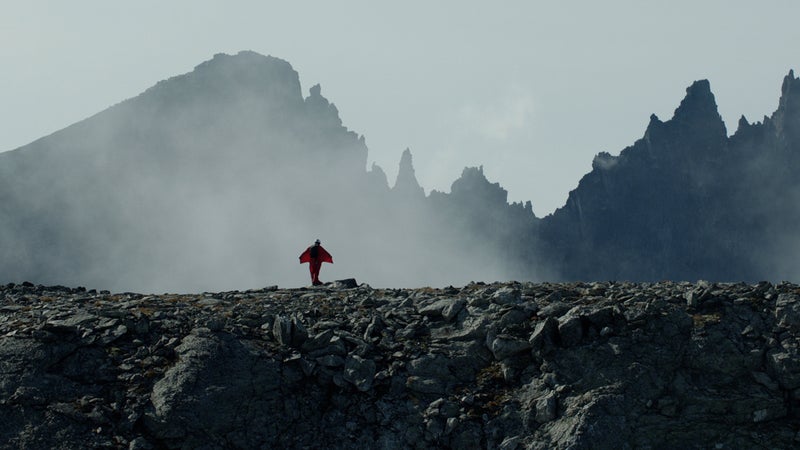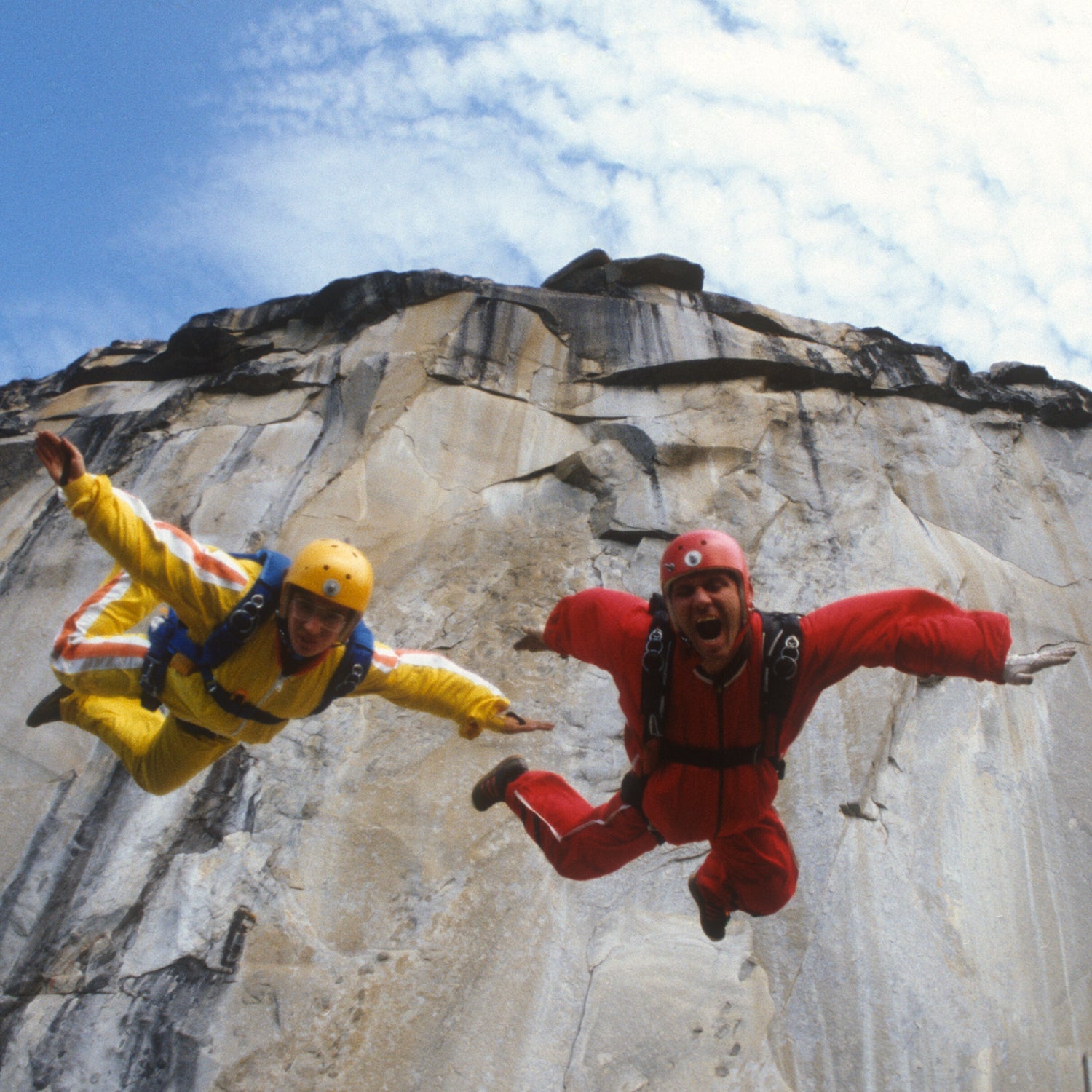Director Marah Strauch’s documentary , opening today in theaters, tells the story of the origins of BASE jumping through the lens of Carl Boenish, a pioneering jumper and aerial cinematographer who helped invent and name the sport. He was also eventually killed by it. The story has become unfortunately poignant given the death last weekend of Dean Potter and Graham Hunt in Yosemite.
It was in Yosemite in the late 1970s that Boenish started what was then known as fixed object parachuting or cliff jumping. An electrical engineer turned aerialist, Boenish left his job behind to pursue skydiving and aerial cinematography full-time. “But,” as he says in an archival interview in the film, “after 1,500 skydives over 15 years, you become so proficient at it that you wonder, ‘Well, what else is out there.’”
Boenish became the ringleader of a band of likeminded jumpers, including his wife, Jean Boenish, who graduated from the cliffs of Yosemite to other objects and locations. He had an offbeat charisma that sometimes verged on manic, but he was also highly organized and practical. He worked tirelessly to legitimize BASE jumping as a legal sport and cataloged its development obsessively, mounting 16mm film cameras to his and his partners’ helmets.

His death, during a jumping accident in Norway in 1984, the day after he and Jean set the Guinness record for world’s highest cliff jump, came as a jolt to a sport still in its infancy. And though decades have passed, Boenish's death—and the film—provokes the same conversations we’re having now after this week’s tragedy. (Boenish was 43 when he died—the same age as Potter.)
The film itself, which took eight years to complete, is a tremendous feat of research, storytelling, and imagination. It splices together Boenish’s personal footage with atmospheric recreations of scenes for which no footage existed, and includes interviews—sometimes funny, sometimes confounding, often emotional—with his co-conspirators from those early days.
���ϳԹ��� spoke with director Marah Strauch about her film last week.
OUTSIDE: Congrats on the film. There’s a bit of a personal angle to your interest in that your uncle, Mike Allen, was an early BASE jumper. How much did you know about him and about that world going into this?
STRAUCH: I grew up knowing a little bit about what he did. He died in a car accident and I really became a detective to find out more about him, so it was a process of discovery for me. But at first I didn’t even know the film would be about Carl and Jean Boenish. I actually went to visit Rick Harrison, another BASE jumper in the film, and he showed me some footage of Carl’s and started telling me stories about him.
Carl was a pretty prolific shooter. How much film were you dealing with?
It was about 70,000 feet of 16mm film, which is probably about 40 hours of footage. Salvaging and transferring that old film is a very lengthy process, and it's very expensive. I did a Kickstarter to get a lot of the footage transferred. And even though Carl was incredibly meticulous—he had this intricate film log, with this very small mechanical pencil writing cataloging every jump he’d ever done and how it was filmed and what stock it was shot on—the history had never been written, so it was a matter of putting it in context, filling in that story.
And you connected with Jean Boenish, who was Carl’s wife and partner in jumping and filmmaking.
Right, eventually I made it to Jean and we started working together. When I told her it was going to be a love story, she got really worried, but she ended up really liking the film.
Can you talk a little about that “love story” aspect of the film and how you used recreations of scenes to fill in some of the blanks?
It’s a love story about Carl's love of BASE jumping and filmmaking, but it's also about Carl and Jean. When we first thought about making this film, we thought about it as a history of BASE jumping, but as we got into it and realized we wanted a larger audience to see this story, it felt like if we just stuck to the archival footage and still photos, it would be hard to create the kind of cinematic arc or include much of the story of their romance. And that was part of the story that we really wanted to tell. So we decided to shoot recreations of some scenes for which footage didn't exist.
“I think as much as my film is about going beyond artificial limitations, it's also about knowing your own limits. The guys that BASE jumped very early on respected their own limits.”
That love affair with the camera and cinematography definitely comes through. The shots are amazing, given the equipment they were using.
I love looking at the technology in the film—the giant 16mm cameras strapped to peoples heads and bodies, often in conjunction with 35mm still cameras. It’s amazing things these people were doing to get these shots, and how physical their filmmaking was. A big part of the joy for Carl was sharing his exploits with other people. That was his motivation, to show people something that they’d really never seen before. And he really thought that, even if you weren't a BASE jumper, this could inspire you to go out in your own life and, as he says, mow the lawn better or bowl a perfect game.
He’s sort of the predecessor of this GoPro-driven, image-saturated action sports world. What do you think he’d make of it?
I mean now with GoPros it's almost like you’re not even wearing anything, it has become part of your body. I think for Carl that would have been like science-fiction. I did an interview previously where I said that he would hate GoPros, and I take it back. I have no idea. I think he would have been very excited that everybody can share their own joy that way. That said, he was a perfectionist. He’d want the footage he shot to be as good as it could possibly be. He would say to Jean, “Don't shoot home movies.” He was a filmmaker. He was not shooting YouTube videos.
There’s something some of your interviewees seem to grapple with a little bit, which is whether, as the originators of this thing, they bear any responsibility for what it's become?
That’s an interesting question. All of them are still living and I don't think they see themselves as responsible for other people's choices to BASE jump. It brought a lot of joy to them and they probably believed it would bring great joy to other people. And I think as much as my film is about going beyond artificial limitations, it's also about knowing your own limits. The guys that BASE jumped very early on respected their own limits.
They’re all still living except Carl. And the circumstances of the jump that killed him are open to some interpretation.
Yeah, that is true. Nobody knows exactly what happened. In that last moment, I think Carl was on a complete high from the Guinness record jump, and I don't think he was checking himself completely, and I think more than anything that's what occurred. It's something I heard again and again growing up from my dad and my uncle, that you always have to check yourself when you're on that kind of high.
This conversation has been condensed and edited.


